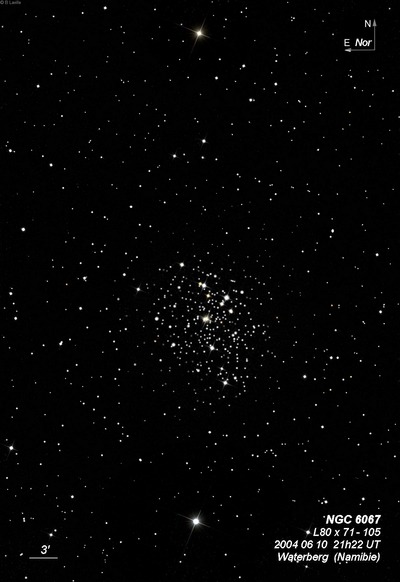
James Dunlop discovered NGC 6067 = D 360 = h3619 on 8 May 1826 and described "a pretty large cluster of small stars of mixed magnitudes, about 12' diameter; the stars are considerably congregated towards the centre, extended south preceding and north following." He made 5 observations of the cluster and his position is unusually accurate.
John Herschel made 3 observations: On 9 Jul 1834 he recorded "the chief star in middle of a most superbly rich and large cluster, 20' at least in diameter, as it much more than fills field; not much compressed in the middle, stars 10..12th mag." On a second sweep he called it "place of a near double star in centre of a superb cluster; very large and rich; composed of equal stars 12th mag, a fine object, Much more than fills field."
200/250mm - 8" (7/13/91 - Southern Baja): At 83x, in excess of 100 stars mag 8-12 in a 20' diameter. Very bright, large, very rich, compressed towards the core, which includes a striking double star at center (h4835 = 8.8/9.4 at 10"). Many stars are arranged in spirals and arcs, rich in faint stars. The brightest mag 7.8 star is located at the south edge with a mag 8 star off the east edge. This is a beautiful open cluster in the rich Norma starcloud!
400/500mm - 18" (7/6/05 - Magellan Observatory, Australia): at 76x (27 Panoptic), this cluster was a stunning sight with a few hundred stars sparkling in a 20' region. NGC 6067 appeared comparable to one the richer Messier clusters. The cluster is compressed towards the center and thins out in the periphery, blending in with the rich, surrounding Milky Way. The cluster includes a few striking pairs with a bright mag 8.8/9.4 pair at 10" near in the center, The duo is collinear with a much closer and fainter equal mag pair. At 228x, the cluster appeared much more irregular and most of the stars seemed to be arranged in elegant loops and chains that enclosed starless holes in the cluster.
Notes by Steve Gottlieb